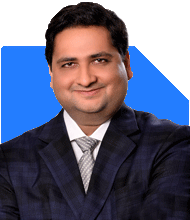I am 44 years old and is currently investing 6K with step up of 10% in Quant small cap , 10k in SBI long term equity fund, and 10k in parag parikh flexi cap fund. My goal is to have 1 crore within 8 years. Whether I am in right investment track to achieve my goal
Ans: Evaluating Your Current Investment Strategy
Your dedication to investing is admirable, and your goal of accumulating Rs 1 crore in 8 years is achievable with strategic planning. Let's analyze your current investments and see how they align with your objective.
Quant Small Cap Fund
Investing Rs 6,000 monthly in a small cap fund with a 10% annual step-up is a bold and potentially rewarding choice. Small cap funds have high growth potential, albeit with greater volatility. Over the long term, small cap funds can deliver impressive returns, but they require patience and a high risk tolerance.
SBI Long Term Equity Fund
Allocating Rs 10,000 monthly to a long-term equity fund is a wise move, particularly for tax-saving purposes under Section 80C. These funds are generally more stable compared to small cap funds, offering a balanced approach to growth and security. They invest in a diversified portfolio of stocks, which helps in mitigating risk.
Parag Parikh Flexi Cap Fund
The Rs 10,000 monthly investment in a flexi cap fund is another strategic decision. Flexi cap funds provide flexibility to the fund manager to invest across large, mid, and small cap stocks, depending on market conditions. This flexibility can lead to better risk-adjusted returns and a more resilient portfolio.
Calculating the Potential to Reach Rs 1 Crore
To assess whether your current investments will help you reach Rs 1 crore in 8 years, let's consider the average annual returns and the power of compounding.
Expected Returns and Compounding
Equity mutual funds typically offer returns ranging from 12% to 15% annually. With your step-up SIP strategy, where you increase your SIP amount by 10% each year, the compounding effect will be significant. The increased contributions over time, coupled with market growth, will accelerate your corpus accumulation.
Enhancing Your Investment Strategy
The Power of Step-Up SIP
Your strategy to increase the SIP amount by 10% annually is excellent. This incremental increase leverages your growing income and maximizes the benefits of compounding. For instance, if you start with Rs 6,000 and increase it by 10% every year, the final corpus will be significantly larger than a flat SIP.
Regular Portfolio Review
It's crucial to review your portfolio regularly. Market conditions, personal financial goals, and life changes can impact your investment strategy. A Certified Financial Planner (CFP) can provide valuable insights and adjustments to keep your investments on track.
Diversification and Risk Management
Balanced Investment Portfolio
Your investments in small cap, long-term equity, and flexi cap funds are well-diversified. This mix offers a balance between high growth potential and stability. Diversification reduces risk and helps in achieving consistent returns.
Considering Debt Funds
While equity funds are excellent for growth, adding a small portion of debt funds can provide stability. Debt funds offer lower but more stable returns, acting as a cushion during market volatility. This can be particularly useful as you approach your goal, reducing the risk of a significant market downturn affecting your corpus.
Market Cycles and Staying Invested
Understanding Market Volatility
Equity markets are cyclical, with periods of growth and correction. Understanding this helps in setting realistic expectations and avoiding panic during downturns. Staying invested through different market cycles often yields better long-term returns.
Avoiding Market Timing
Trying to time the market can lead to missed opportunities and losses. Consistent investing, regardless of market conditions, is a more effective strategy. Your SIPs automatically buy more units when prices are low, benefiting from rupee cost averaging.
Importance of Early Investment and Incremental Increases
Benefits of Compounding
Starting investments early and increasing contributions incrementally maximizes the benefits of compounding. The longer your money is invested, the more it grows. Your step-up SIP strategy harnesses this power effectively.
Managing Emotions in Investing
Staying Calm During Volatility
Investing involves emotions, especially during market fluctuations. Market downturns can cause anxiety, but a well-defined plan and professional guidance help in staying focused on long-term goals. Avoid making impulsive decisions based on short-term market movements.
Professional Guidance
Relying on your CFP for advice during volatile times can provide an objective perspective and reduce emotional biases. A CFP can help you stay disciplined and make informed decisions aligned with your financial goals.
Financial Tools and Resources
Leveraging Financial Tools
Use financial tools to track and manage your investments. SIP calculators, portfolio trackers, and financial planning software can help stay organized and make informed decisions.
SIP Calculators
Estimating future returns and planning contributions effectively using SIP calculators helps set realistic goals and track progress. This can provide a clear picture of your investment journey and the adjustments needed to reach your target.
Adapting to Life Changes
Life Events and Financial Goals
Life events like marriage, childbirth, or career changes can impact your financial goals and capacities. Adapt your investment strategy accordingly. Reevaluate your goals periodically to ensure they align with your evolving needs.
Adjusting Contributions
Increase contributions during income growth phases and reduce them if expenses rise temporarily. This flexibility helps in maintaining a balanced approach to savings and expenditures.
Tax Benefits and Efficient Planning
Utilizing Tax Benefits
Tax planning is essential to maximize your net returns. Utilize tax-saving instruments effectively, such as long-term equity funds for Section 80C deductions. Proper tax planning enhances your overall returns by reducing the tax burden.
Long-Term Capital Gains (LTCG)
Equity investments held for over a year qualify for LTCG, which are taxed favorably compared to short-term gains. Planning your investments to optimize tax benefits can enhance your net returns.
Insurance and Risk Management
Adequate Insurance Coverage
Ensure sufficient life and health insurance coverage. This protects your family from unforeseen events and secures your financial plans. Term insurance is cost-effective and provides substantial coverage.
Separating Insurance and Investment
If you hold LIC, ULIPs, or investment-cum-insurance policies, consider surrendering them. These often provide suboptimal returns due to high charges and mixing insurance with investment. Reinvesting the proceeds into mutual funds can optimize growth.
Regular Portfolio Review
Annual Reviews
Conduct detailed reviews annually. Assess performance, rebalance asset allocation, and make necessary changes. This ensures your investments align with your goals.
Rebalancing
Rebalance your portfolio periodically to maintain the desired risk-return profile. This involves selling overperforming assets and buying underperforming ones to ensure optimal allocation.
Understanding Financial Market Dynamics
Long-Term Growth
Historically, equity markets have provided superior returns over the long term. Understanding market dynamics, economic indicators, and global trends helps set realistic expectations and stay committed to your investment plan.
Diversification Across Sectors
Investing in different sectors such as technology, healthcare, and finance reduces sector-specific risks. A diversified portfolio across various sectors enhances stability and growth potential.
Setting Realistic Financial Goals
Assessing Financial Milestones
Setting realistic financial milestones helps track progress and stay motivated. Break down your Rs 1 crore goal into smaller, achievable targets. This makes the journey manageable and provides a clear roadmap.
Periodic Goal Evaluation
Evaluate your financial goals periodically. Adjust them based on changes in income, expenses, and market conditions. Regular evaluation ensures your goals remain relevant and attainable.
Professional Financial Planning
Benefits of a CFP
A Certified Financial Planner (CFP) provides expert advice tailored to your financial goals. They offer insights into market trends, tax planning, and portfolio management, ensuring optimal growth and risk management.
Personalized Financial Strategies
A CFP develops personalized financial strategies based on your risk tolerance, financial goals, and market conditions. Their expertise helps in making informed decisions and achieving financial milestones.
Final Insights
Achieving Rs 1 crore in 8 years is ambitious but feasible with a strategic approach. Your current investments in small cap, long-term equity, and flexi cap funds form a solid foundation. Increasing your SIP contributions, leveraging actively managed funds, and conducting regular portfolio reviews will optimize growth. Diversifying further with debt funds, understanding market cycles, and managing emotions during volatility are essential. Adapting to life changes, efficient tax planning, and adequate insurance coverage ensure comprehensive financial security. With discipline, patience, and professional guidance, you can reach your Rs 1 crore goal and secure a prosperous future.
Best Regards,
K. Ramalingam, MBA, CFP
Chief Financial Planner
www.holisticinvestment.in



























